From Satellites to Substations: Copernicus Powers a Resilient and Efficient Energy Sector

The European Union's ambitious climate goals are driving a historic shift in the energy landscape. To succeed, the sector needs reliable, accessible, and accurate environmental information. Copernicus, the EU's Earth Observation programme, delivers this by providing a continuous stream of data on our planet's atmosphere, land, and seas, empowering the energy industry to make data-driven decisions.
To guide stakeholders, the European Union Agency for the Space Programme (EUSPA) has recently published the Copernicus for Energy Guidelines Document. This comprehensive resource explains how free and open data from Copernicus Sentinel satellites and its specialised services (CAMS, C3S, CEMS ) can be applied to improve project planning, optimise operations, and manage risks with confidence.
To bridge the gap between data and practical application, EUSPA actively fosters innovation through targeted proofs of concept (PoCs) to support market uptake of Copernicus based solutions. The agency identifies key operational challenges within strategic sectors like energy and facilitates collaboration between commercial end-users and expert Earth Observation (EO) solution providers. EUSPA then supports the implementation of these PoCs, helping to design the project, validate the results in a real-world setting, and demonstrate the economic and operational benefits, thereby de-risking the adoption of space-based solutions
Enhancing Planning and Bankability
Accurate resource assessment and risk analysis are fundamental to securing investment for new energy projects. Copernicus provides the historical data and climate projections needed to build bankable business cases.
- Reliable Solar Assessments: For financial institutions to back new photovoltaic (PV) projects, they need to trust long-term performance predictions. Raiffeisen Bank Czech Republic has collaborated with EUSPA, ARMINES, and Evenflow, to demonstrate how the use of solar radiation data from the Copernicus Atmosphere Monitoring Service (CAMS) and climate reanalysis from the Copernicus Climate Change Service (C3S) can estimate solar yield with high accuracy. This allows financial models to better assess the return on investment, boosting the bankability of solar installations.
- Improved Solar Forecasting for Energy Management: Belgian energy company Luminus uses an Energy Management System to optimise local energy assets. With support from EUSPA, Reuniwatt showcased a new forecasting model that uses Copernicus Atmosphere Monitoring Service (CAMS) data to provide precise, near-real-time solar power generation forecasts. These improved forecasts enable Luminus to proactively manage its assets (including curtailment) and enhance its service for customers.
- Hydropower and Flood Risk: Hydropower operators must prepare for extreme weather. Italian company GECOsistema developed a platform using C3S data to analyze flood probabilities and intensities. This allows operators to assess the resilience of dam spillways under different climate scenarios, ensuring long-term operational safety, especially in regions where local data is sparse.
Securing the Grid and Optimising Operations
A stable and resilient electricity grid is the backbone of the energy transition. Copernicus delivers critical intelligence for monitoring vast infrastructure networks, mitigating physical risks, and balancing a complex energy mix.
- Automated Infrastructure Monitoring: Grid operators must prevent non-compliant construction near powerlines. For the Spanish operator i-DE (Iberdrola Group), Dutch service provider NEO demonstrated a solution using Copernicus Sentinel-2 data to automatically detect changes and construction activity. This cost-effective early warning system would allow i-DE to dispatch inspection teams only when necessary, saving time and resources.
- Mitigating Climate Threats to the Grid: Electrical infrastructure is increasingly vulnerable to wildfires and floods. Planetek showcased a solution for Enel Grids that integrates data from the Copernicus Emergency Management Service (CEMS) and Copernicus Land Monitoring Service (CLMS) to generate detailed vulnerability and risk maps. This enables Enel to proactively identify high-risk areas and implement targeted mitigation measures to protect its assets.
- Smarter Grid Balancing with Solar: The rise of decentralised solar PV installations creates challenges for grid stability. Solutions powered by CAMS and C3S data, provide highly accurate solar power forecasts. This allows grid operators, such as RTE, to better anticipate fluctuations in energy supply, reducing their costly reliance on reserve power margins and supporting a more stable grid.
- Automated Solar Farm Construction Monitoring: For Portuguese utility EDP, managing a rapidly growing portfolio of solar assets requires efficient oversight. A proof-of-concept supported by EUSPA and implemented by IT company COTESA demonstrated how Copernicus Sentinel-2 data can automatically detect and monitor the construction progress of new solar PV installations. This reduces the need for manual inspections, allowing EDP to improve project oversight and scale its auditing processes cost-effectively
Learn More at ENLIT Europe 2025
To discover more about how EU Space can power the energy sector, meet the EUSPA team at ENLIT Europe 2025 in Bilbao.
Visit us at stand 5.F30-S017 and join our insightful session:
- Session: Integrating Satellite Data into Energy Operations: Use Cases and Insights
- Date and Time: 18 November 2025, 14:00 - 15:30
- Location: EU Projects Zone Hub - Theatre 3 (Hall 5)
Media note: This feature can be republished without charge provided the European Union Agency for the Space Programme (EUSPA) is acknowledged as the source at the top or the bottom of the story. You must request permission before you use any of the photographs on the site. If you republish, we would be grateful if you could link back to the EUSPA website.